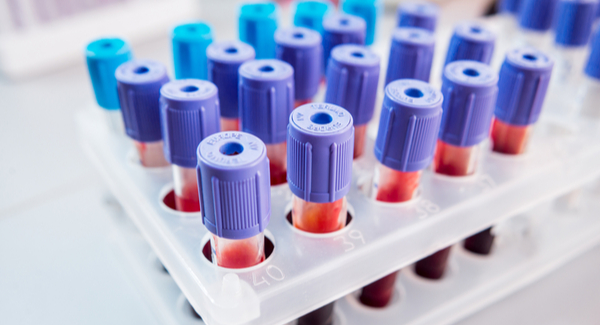Testing for Rheumatoid Arthritis
Understand the lab and imaging tests used to diagnose and monitor disease activity in RA.
By Mary Anne Dunkin | June 12, 2022
Diagnosing rheumatoid arthritis (RA) can take time. Like other forms of arthritis, a diagnosis is based largely on the findings from a medical exam and your symptoms. These may include joint pain, tenderness and swelling that affects the same joint or joints on both sides of your body (like both wrists or both knees); fatigue and fever. Lab tests and imaging tests can help your doctor make the diagnosis.
Diagnostic Lab Tests
Evidence of RA may be seen in the blood, so blood tests play an important role in making a diagnosis. Following are some of the tests your doctor may order.
- Erythrocyte sedimentation rate (ESR or sed rate). The ESR can gauge how much inflammation is in your body by measuring how quickly red blood cells (erythrocytes) separate from other cells in the blood and collect as sediment in the bottom of a test tube. Because inflammation can be caused by conditions other than RA, the results must be considered along with those of other tests when making an RA diagnosis.
- C-Reactive Protein (CRP). This measures levels of CRP, a protein produced by the liver that signals inflammation. High CRP levels are common in RA and other inflammatory forms of arthritis. Because a high CRP may be present with many diseases and conditions, a high CRP in itself does not mean you have arthritis or identify which form you may have. The results must be interpreted in the context of your symptoms as well as the results of other tests.
- Rheumatoid factor (RF). Rheumatoid factor is a protein made by the immune system which may attack healthy tissues. High levels of rheumatoid factor could help your doctor make a diagnosis of RA. However, RF levels may also be high in other autoimmune diseases, so an RF test alone cannot be used to diagnose RA.
- Anti-CCP antibody test (ACCP or CCP). This test is for a type of autoantibody called cyclic citrullinated peptide (CCP) antibodies, which can be found in the blood of 60% to 80% of people with rheumatoid arthritis. The test is often conducted along with an RF test.
- Antinuclear antibody test (ANA). Antinuclear antibodies (ANA) are a type of autoantibody, a protein that attacks your body’s own tissues. The presence of ANAs can indicate an autoimmune condition, including RA.
Diagnostic Imaging Tests
Imaging tests, along with the physical exam and laboratory tests, can help identify RA. These imaging tests may be used to diagnose RA.
- X-ray. X-rays can show bone damage, characteristic of RA, where they meet at joints. They are a common tool in diagnosis; however, because it damage from inflammation develops over time and may not be visible via X-ray early on, it may not be useful for diagnosing early RA.
- Magnetic resonance imaging (MRI). MRI is procedure in which radio waves and a powerful magnet linked to a computer are used to create 3D images of structures inside the body. MRI can show changes in cartilage and bone that are indicative of RA.
- Ultrasound. Ultrasound, or sonography, uses sound waves to create pictures of structures inside the body. THis may be used to view changes in bones and cartilage suggestive of RA before any changes show up on X-ray. Other benefits of ultrasound include its relatively low cost and the fact it doesn’t expose the body to radiation, like X-ray.
- Computed tomagraphy (CT) scan. A CT scan is an imaging procedure that combines a series of X-ray images to create cross-sectional images of parts of the body. Studies show CT scans may be effective for viewing early bone erosions that occur with RA.
Monitoring Lab Tests
Some of the same lab and imaging tests used in diagnosing RA are also used to monitor disease progression and response to treatment. Your doctor may order other tests to look for side effects of medications used to treat RA or effects of the disease itself. Your doctor may order some of these lab tests during your treatment.
- Erythrocyte sedimentation rate (ESR or sed rate). A reduced sed rate is an indication that inflammation is being controlled.
- C-Reactive Protein (CRP). As with sed rate, lower levels of CRP indicate that inflammation is being controlled.
- The MBDA test (Vectra DA). This blood test checks for 12 proteins, hormones and growth factors. It gives your doctor a single disease activity score that can indicate how aggressive your disease is, how likely you are to have a flare when stopping medications and what drug combinations may work best for you.
- Complete Blood Count (CBC). While the CBC won’t necessarily tell your doctor how active your disease it is, components of the test can help if you have complications from RA or its treatment. For example, low red blood cell levels indicate anemia, which is common in people with RA. Low white blood cells, which are needed to fight infection, and low platelets, which are needed to make blood clot, can sometimes occur in people taking biologics.
- Liver enzyme (SGOT, SGPT, bilirubin, alkaline phosphatase). Measuring levels of enzymes in the blood can help your doctor determine if you have liver damage, which may be related to RA treatment, an associated autoimmune condition or RA itself.
- Hematocrit (HCT) and hemoglobin (Hgb). These tests measure your number and quality of red blood cells. Lower red blood cell counts may mean medications, such as NSAIDs or corticosteroids, are causing gastrointestinal bleeding.
- Lipid panel. Because some medications for RA, such as interleukin inhibitors and JAK inhibitors, may cause increases in your triglyceride and cholesterol levels, your doctor may check those levels during RA treatment and prescribe medication to lower lipid levels if necessary.
- Kidney function tests. Lab tests performed on your blood and urine can tell your doctor how well your kidneys are removing waste products from the body. Kidney damage may occur due to RA itself or medications used to treat it, including nonsteroidal anti-inflammatory drugs (NSAIDs), disease-modifying antirheumatic drugs (DMARDs), corticosteroids and biologics.
Monitoring Imaging Tests
A variety of imaging tests may be used to monitor joint damage resulting from inflammation. They may be the same as those used in diagnosing RA, including
- X-ray
- Magnetic resonance imaging (MRI)
- Ultrasound
- CT Scan

Stay in the Know. Live in the Yes.
Get involved with the arthritis community. Tell us a little about yourself and, based on your interests, you’ll receive emails packed with the latest information and resources to live your best life and connect with others.



